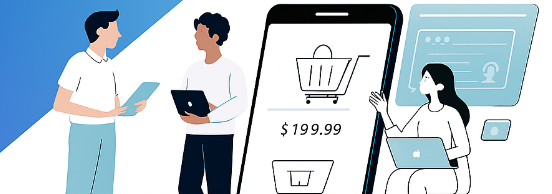
- Product

- Pricing
- Affiliate Program
- Use Cases
- Resource


Each year brings new challenges and opportunities in affiliate marketing. Just when you think you’ve mastered all the techniques, the market shifts—new tools, technologies, and formats emerge. This is especially true for e-commerce, which remains one of the most profitable and dynamic verticals. To stay competitive, you must anticipate where the market is heading.
By 2025, 44% of U.S. e-commerce sales (over $312 billion) are expected to come from mobile. Globally, mobile purchases will reach 62% by 2027.
Key actions:
Ensure your landing pages are mobile-optimized.
Use short, concise copy.
Upload images optimized for fast mobile loading.
Mobile optimization is now a strategy, not just responsive design.
Implement:
Micro-animations for interactive feedback.
Sticky purchase or chat buttons.
Single-purpose landing pages to boost conversions.
Tip: Use MoreLogin to test mobile landing pages and manage multiple accounts without risking bans.
Shopping inside social apps is the new normal. Facebook Marketplace now serves 250M sellers, with over half of users making purchases there.
Younger audiences favor TikTok—thanks to Shop features, live shopping, and in-video product cards.
Key takeaways:
Users want “see → tap → buy” simplicity.
Focus on short-form video, livestreams, and content-integrated product placements.
Hyper-personalization drives conversions. AI tracks user behavior and suggests relevant products.
Example: Amazon earns 35% of its revenue via AI-powered upselling and cross-selling.
Affiliate marketers can apply this via:
Upselling higher-tier products
Cross-selling accessories
Post-purchase upsells for immediate follow-ups
More precise targeting means higher ROI.
Consumers increasingly buy based on images, not text. High-quality visuals, demo videos, animations, even AR drive attention and conversions.
Tips:
Use WebP format for fast-loading high-res images.
Add SEO tags to images.
Leverage UGC (user-generated content) for authenticity.
Explore Pinterest Ads for supplemental traffic.
Shoppers bounce between TikTok, Google, and email before buying. Your presence must be cohesive across all platforms.
Benefits:
Unified messaging
More data = better personalization
Increased customer LTV and retention
Using 3+ channels can nearly triple conversion rates.
MoreLogin creates a separate browser environment for each account—unique IP, user-agent, cookies, and browser fingerprint, as if working from different devices.
Example: You run 10 Shopify stores in various regions. With MoreLogin, each store is isolated like it's on a separate machine—no overlap or cross-contamination.
Quick setup:
Create 5 ad funnels → 5 MoreLogin profiles → 5 Facebook accounts → same offer with different creatives → track results → scale the winner.
Sustainable consumption and eco-branding are now expectations.
Instant payments (Apple Pay, Google Pay, crypto) are mandatory.
Subscription models (SaaS-style) ensure recurring revenue and loyal customers.
E-commerce is not just about products—it’s about behavior, emotion, and tech. The demand for physical goods isn’t going anywhere, and neither are arbitrage opportunities.
To lead, not follow, adopt cutting-edge tools like MoreLogin, AI personalization, and omnichannel strategies.
Test, analyze, scale—and never stop evolving.